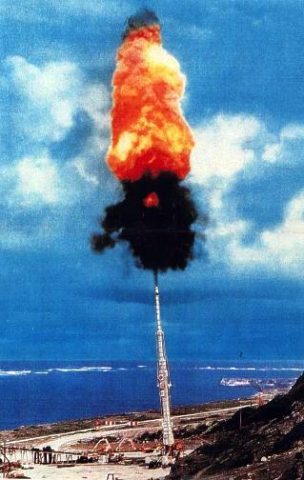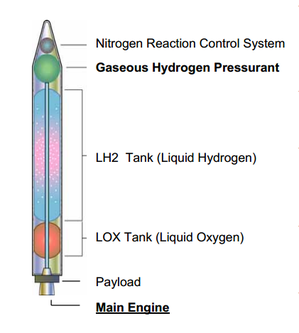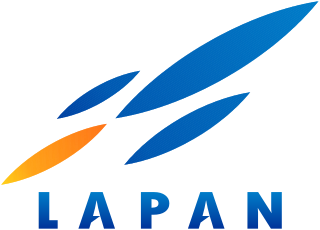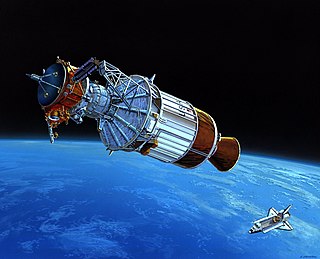| Company type | Private |
|---|---|
| Industry | Aerospace |
| Founded | 2010 |
| Headquarters | California, US |
Key people | John Hunter (not at present) |
| Website | quicklaunchinc.com |
Quicklaunch is an inactive US company attempting to use a type of space gun to launch payloads into low Earth orbit. It is a university spin-off of the SHARP project which ended 2005.
The Quicklaunch proposed firing apparatus was a light-gas gun using hydrogen as the working gas and natural gas as the explosive heat source. Heating and pre-pressurizing the hydrogen working gas takes 10 minutes before the shot and most of the hydrogen is recovered by a muzzle muffler at the end of the launch tube to be reused for subsequent launches.
The 1,100-metre-long (3,600 ft) gun would be, for the most part, submerged in the ocean. Its horizontal and vertical direction (azimuth and elevation) could be adjusted based on customer launch requirements.
The proposed launcher was designed to give projectiles an initial speed of 6 km/s (3.7 mi/s) while the Earth orbital speed is 6.9 to 7.8 km/s (4.3 to 4.8 mi/s). The projectile design therefore included a one-stage rocket which ignites some time after launch. The designed payloads could include spacecraft, satellites, consumable, water or fuel to supply a propellant depot in orbit.
Projected costs to orbit were $500 per pound ($1,100/kg). [1] [2]
In a 2016 article, Hunter remarked that the work had been put in stasis due in part to Elon Musk's company, SpaceX, taking up the challenge of reducing costs to orbit. Hunter however invited someone with a similar level of money and motivation, to take a fresh look at the approach. [4] Later, Hunter ran a new start-up called Green Launch that is also developing a space light-gas gun.

A single-stage-to-orbit (SSTO) vehicle reaches orbit from the surface of a body using only propellants and fluids and without expending tanks, engines, or other major hardware. The term exclusively refers to reusable vehicles. To date, no Earth-launched SSTO launch vehicles have ever been flown; orbital launches from Earth have been performed by either fully or partially expendable multi-stage rockets.

A mass driver or electromagnetic catapult is a proposed method of non-rocket spacelaunch which would use a linear motor to accelerate and catapult payloads up to high speeds. Existing and proposed mass drivers use coils of wire energized by electricity to make electromagnets, though a rotary mass driver has also been proposed. Sequential firing of a row of electromagnets accelerates the payload along a path. After leaving the path, the payload continues to move due to momentum.

The Jupiter-C was an American research and development vehicle developed from the Jupiter-A. Jupiter-C was used for three uncrewed sub-orbital spaceflights in 1956 and 1957 to test re-entry nosecones that were later to be deployed on the more advanced PGM-19 Jupiter mobile missile. The recovered nosecone was displayed in the Oval Office as part of President Dwight D. Eisenhower's televised speech on November 7, 1957.

The Centaur is a family of rocket propelled upper stages that has been in use since 1962. It is currently produced by U.S. launch service provider United Launch Alliance, with one main active version and one version under development. The 3.05 m (10.0 ft) diameter Common Centaur/Centaur III flies as the upper stage of the Atlas V launch vehicle, and the 5.4 m (18 ft) diameter Centaur V has been developed as the upper stage of ULA's new Vulcan rocket. Centaur was the first rocket stage to use liquid hydrogen (LH2) and liquid oxygen (LOX) propellants, a high-energy combination that is ideal for upper stages but has significant handling difficulties.

The Polar Satellite Launch Vehicle (PSLV) is an expendable medium-lift launch vehicle designed and operated by the Indian Space Research Organisation (ISRO). It was developed to allow India to launch its Indian Remote Sensing (IRS) satellites into Sun-synchronous orbits, a service that was, until the advent of the PSLV in 1993, only commercially available from Russia. PSLV can also launch small size satellites into Geostationary Transfer Orbit (GTO).

Project HARP, for high altitude research project, was a joint venture of the United States Department of Defense and Canada's Department of National Defence created with the goal of studying ballistics of re-entry vehicles and collecting upper atmospheric data for research. Unlike conventional space launching methods that rely on rockets, HARP instead used very large guns to fire projectiles into the atmosphere at extremely high speeds.

Skylon is a series of concept designs for a reusable single-stage-to-orbit spaceplane by the British company Reaction Engines Limited (Reaction), using SABRE, a combined-cycle, air-breathing rocket propulsion system.

A space gun, sometimes called a Verne gun because of its appearance in From the Earth to the Moon by Jules Verne, is a method of launching an object into space using a large gun- or cannon-like structure. Space guns could thus potentially provide a method of non-rocket spacelaunch. It has been conjectured that space guns could place satellites into Earth's orbit, and could also launch spacecraft beyond Earth's gravitational pull and into other parts of the Solar System by exceeding Earth's escape velocity of about 11.20 km/s. However, these speeds are too far into the hypersonic range for most practical propulsion systems and also would cause most objects to burn up due to aerodynamic heating or be torn apart by aerodynamic drag. Therefore, a more likely future use of space guns would be to launch objects into Low Earth orbit, at which point attached rockets could be fired or the objects could be "collected" by maneuverable orbiting satellites.

A launch vehicle is typically a rocket-powered vehicle designed to carry a payload from Earth's surface or lower atmosphere to outer space. The most common form is the ballistic missile-shaped multistage rocket, but the term is more general and also encompasses vehicles like the Space Shuttle. Most launch vehicles operate from a launch pad, supported by a launch control center and systems such as vehicle assembly and fueling. Launch vehicles are engineered with advanced aerodynamics and technologies, which contribute to high operating costs.
The Super High Altitude Research Project was a U.S. government project conducting research into the firing of high-velocity projectiles high into the atmosphere using a two-stage light-gas gun, with the ultimate goal of propelling satellites into Earth orbit. Design work on the prototype space gun began as early as 1985 at the Lawrence Livermore National Laboratory in California and became operational in December 1992. It is the largest gas gun in the world.
John Hunter is an American projectile researcher, who developed the 1994 "supergun" Super High Altitude Research Project (SHARP) at the Lawrence Livermore National Laboratory. The ultimate aim of his research is to shoot payloads into space, at less than one tenth of the cost of unmanned rockets. John Hunter was the director of Quicklaunch until 2012 and currently runs a startup called Green Launch that is developing a light-gas gun concept

Aquarius is a launch vehicle concept designed for low-cost by Space Systems/Loral to carry small, inexpensive payloads into low earth orbit.

The National Institute of Aeronautics and Space was the Indonesian government's space agency. It was established on 27 November 1963, by former Indonesian president Sukarno, after one year's existence of a previous, informal space agency organization. LAPAN is responsible for long-term civilian and military aerospace research.

The Inertial Upper Stage (IUS), originally designated the Interim Upper Stage, was a two-stage, solid-fueled space launch system developed by Boeing for the United States Air Force beginning in 1976 for raising payloads from low Earth orbit to higher orbits or interplanetary trajectories following launch aboard a Titan 34D or Titan IV rocket as its upper stage, or from the payload bay of the Space Shuttle as a space tug.

Non-rocket spacelaunch refers to theoretical concepts for launch into space where much of the speed and altitude needed to achieve orbit is provided by a propulsion technique that is not subject to the limits of the rocket equation. Although all space launches to date have been rockets, a number of alternatives to rockets have been proposed. In some systems, such as a combination launch system, skyhook, rocket sled launch, rockoon, or air launch, a portion of the total delta-v may be provided, either directly or indirectly, by using rocket propulsion.

An orbital propellant depot is a cache of propellant that is placed in orbit around Earth or another body to allow spacecraft or the transfer stage of the spacecraft to be fueled in space. It is one of the types of space resource depots that have been proposed for enabling infrastructure-based space exploration. Many depot concepts exist depending on the type of fuel to be supplied, location, or type of depot which may also include a propellant tanker that delivers a single load to a spacecraft at a specified orbital location and then departs. In-space fuel depots are not necessarily located near or at a space station.
A ram accelerator is a device for accelerating projectiles or just a single projectile to extremely high speeds using jet-engine-like propulsion cycles based on ramjet or scramjet combustion processes. It is thought to be possible to achieve non-rocket spacelaunch with this technology.
Airborne Launch Assist Space Access, or DARPA ALASA is a canceled program of the US defense technology agency DARPA "designed to produce a rocket capable of launching a 100-pound satellite into low Earth orbit for less than $1 million." The program was conceived, then announced in 2011, and funded development work began in 2012. The project was terminated in late 2015.
OneSpace or One Space Technology Group is a Chinese private space launch group based in Beijing, subsidiaries in Chongqing, Shenzhen and Xi'an. OneSpace was founded in 2015. OneSpace is led by CEO Shu Chang, and is targeting the small launcher market for microsatellites and nanosatellites. OneSpace launched China's first private rocket in 2018.

Shuttle-Centaur was a version of the Centaur upper stage rocket designed to be carried aloft inside the Space Shuttle and used to launch satellites into high Earth orbits or probes into deep space. Two variants were developed: Centaur G-Prime, which was planned to launch the Galileo and Ulysses robotic probes to Jupiter, and Centaur G, a shortened version planned for use with United States Department of Defense Milstar satellites and the Magellan Venus probe. The powerful Centaur upper stage allowed for heavier deep space probes, and for them to reach Jupiter sooner, prolonging the operational life of the spacecraft. However, neither variant ever flew on a Shuttle. Support for the project came from the United States Air Force (USAF) and the National Reconnaissance Office, which asserted that its classified satellites required the power of Centaur. The USAF agreed to pay half the design and development costs of Centaur G, and the National Aeronautics and Space Administration (NASA) paid the other half.